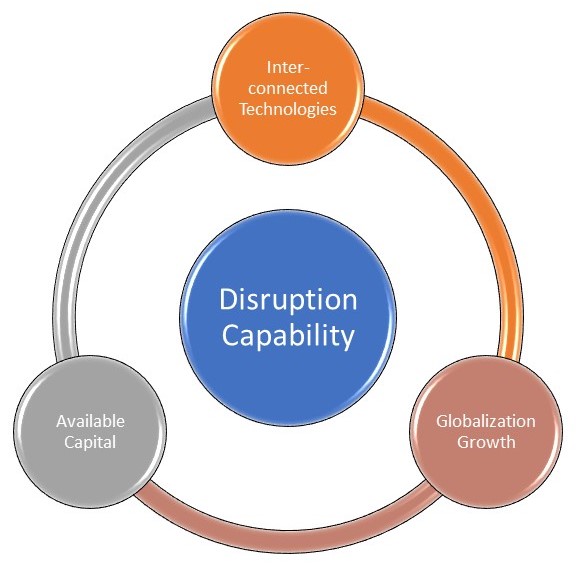“How do you help me?”
Every Potential Client I’ve Ever Talked To
That, or a question just like it, is always one of the first things that my customers want to know. Which doesn’t offend me as I ask similar questions as well when someone wants to sell me something.
And my response goes something like this:
93% of Executives are convinced that their industry will be disrupted in the next 5 years. Do you have a plan to deal with that disruption?
Me – although I’m not sure how well my link comes across when I speak
The reasons that so many executives feel that their industries are ripe for disruption is because of the convergence of readily available capital – allowing companies to scale quickly, the globalization of business – introducing new competition from across the globe, and the ever advancing and connectivity of technology.
If you notice, all three of those things play together. You can now build new capabilities quickly because of the inter-connected technology, with the people you bring on because of the money you raise to address your now global customer demand.

But there’s a catch in that statement. That inter-connectiveness in the technology makes you more reliant on outside forces. And when those outside forces act selfishly, it can often be at your own expense. The latest example of this was Facebook. Let’s take a closer look at this example.
Facebook, and the Data Theft that Never Was
There was a big dust up this past December (2018 – for those of you reading long into the future) about Facebook sharing data about its users. As the story goes, they were collecting as much data as they could, and then picking and choosing which companies to provide it to. It was almost like Facebook was acting like a privately-owned for-profit company, and it was trying to generate as much revenue as possible.
Newsflash – it is. And when you agree to use their platform you agree to their data collection terms. Of course, they are going to give preferential treatment to the companies (call them partners) that benefit them. And of course, they are going to do whatever they can to cut off other companies (call them competitors) that are a threat.
As a responsible business leader, wouldn’t you?
Now, follow me on a little hypothetical. What if YOU became their competitor? Or what if they picked a fight with you? What would stop them from cutting you off?
A Quiz About YOU!
I once began exploring a smartphone game that would quiz you on your own life. More specifically, I would quiz you about your online life. For the prototype, I would pull information from your Facebook friend feed, and ask you a question about the person you saw. You can see a quick mock-up to the below.

Besides the “who is this question,” Facebook provides a lot of information that we could have made questions about. “Where did Joe Smith go to school?” “Where did Joe Smith grow up?” “Where does Joe Smith live now?”
But the issue was, and continues to be, I was 100% reliant on Facebook’s APIs. There was no way around it. I needed their data. The data that they owned. If they ever took notice of my success, they could take measures to either make it financially cost prohibitive, change their policies to where I would not be able to get the information I needed, or simply build a competitor closer to the source.
Just like they are doing with the dating app they are rolling out. They saw the success that Tinder and Bumble were having using Facebook’s own data. So now they are jumping in.
Dealing with External Influencers
While the article above was about Facebook, there are plenty of other organizations that are offering “platforms” for companies to build on. What would happen if one of them exerted their control?
What if Amazon prevents you from selling your items in their digital store front? What if Google plays with your search rankings? While those three (Facebook being the third) are the most obvious choices, any and all companies that you integrate with simultaneously make your offerings stronger, AND if proper steps aren’t taken, allows the company to exert control over you.
Detecting Influencers
If those previous paragraphs make you worried about your businesses exposure, I recommend that you perform a Porters 5 Forces Analysis. It is a great way to determine where your business is susceptible to outside pressures. And the outcome(s) of this analysis should immediately feed into your risk mitigation strategies, and ultimately your innovation pipeline, for further examination.
I could continue writing about this subject; however, anything that I would write would essentially be plagiarism of what Michael Porter already wrote. So, I’ll leave it at the link above and the suggestion that you Google Michael Porter 5 Forces Analysis (and yes, Google does exert control over the results that you see).
Addressing Influencers
Addressing your businesses exposure to technical platforms comes down to two things: controlling your data and building redundancies.
Controlling Your Data
When you own the data, nobody can take it away from you. Data is the building blocks for all IT solutions, and getting it where it needs to be when it needs to be there is the key to making anything of value.

If you are dependent on an outside system’s data, say you query Facebook’s APIs to get information relating to your target’s friend list like my example above, then they hold significant leverage over you.
Correction, they hold all of the leverage.
If however, you reach out to Facebook through their APIs to flush out background information relating to your target, BUT you capture that data, hold it locally and aren’t reliant on it. They they hold less leverage over you. Or no leverage. This is a very viable strategy for data that doesn’t change often.
Building Redundancies
I understand that building redundancies can sometimes seem like re-doing work that has already been accomplished. The upside is it gives your customers more ways to interact with your brand and reduces you dependencies on any one supplier.
This is why you see apps and websites that don’t just offer a Facebook login option, but also Google and sometimes now Amazon. If Facebook decides to no longer allow companies to use its services to authenticate users, those companies can fall back on Google and Amazon.
Grocery stores do this. They know that their customers want ice cream. Yet they don’t just get Breyers ice cream. Because that would give them too much leverage. They get Breyers and Haagen-Dazs and many other brands.
You are beginning to see this more in retail stores as well now. They are beginning to merge their physical stores with an online presence. You can still only buy the same merchandise as both the online and store pull from the same supply. But now you have options on how to get it. With each option having its own strengths and weaknesses, it provides flexibility for their customers and reduces any exposure they face in regards to customer purchasing habits.
Continual Innovation
Which brings us to this idea of continual innovation. When used properly, the idea of continual innovation helps leaders address the areas of exposure. We talk about capturing feedback from employees, customers and non-customers, and using those ideas to drive corporate offerings forward. A second part of that is identifying risks and addressing those risks through your innovation pipeline.
If you use the Porter’s Five Forces method referenced above and notice that you have a supplier with too much leverage, add that to the pipeline. Look for ways to mitigate that leverage. Because if there is one that all business executives know, is that if someone has leverage over you, they are going to use it.
And that’s why we promote this idea of continuous innovation. That’s why we created the InnoSpecting Framework and why we created the Four Pillars of Continuous Innovation. To help you build a brand that is resistant to disruption. And to do that, you have to do whatever you can to address exposures.